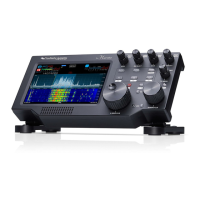FLEX-6000 Signature Series – Maestro User Guide
Page 49
Copyright 2019 FlexRadio Systems. All Rights Reserved.
Operating with AGC turned OFF may be desired by operators who want to avoid having a strong
signal drive a weak nearby signal into the noise floor resulting from AGC audio attenuation. Digital
mode operation may benefit from this configuration.
To adjust the AGC Threshold, tune to a quiet spot between stations. Starting with the AGC-T at a high
value decrease the AGC-T until the background noise just begins to decrease. This is the AGC-T
"sweet spot" or the "knee" of the AGC algorithm. Depending on band conditions, if the AGC-T is set
below 50, you may have to compensate for the loss in audio gain (volume) by increasing the Slice
volume to a higher value. When you get the knee and AF volume adjustment correct for the band
conditions, it will keep the volume of strong signals constant which will allow weaker signals to be
heard even with AGC in FAST mode. Thus AGC-T is one of the most important adjustments, and often
overlooked, to achieve the maximum weak signal receive performance out of the FLEX- 6000 series
SDRs.
The Automatic Gain Control Threshold (AGC-T) adjustment is located on the AF/AGCT/SQL multi-
function control. Each Slice Receiver has its own settings for the AGC timing and threshold.
The AGC attack/release time is controlled by the AGC button on the Slice Receiver Menu. You can
choose FAST, MEDium, SLOW or OFF.
12.2 DSP NOISE MITIGATION FEATURES
The Slice Receiver Menu contains the enable buttons and threshold adjustments for the Wideband
Noise Blanker, Slice Specific Noise Blanker, Noise Reduction, and Automatic Notch Filter. The
midrange settings of the threshold controls are good starting points for adjustments.
12.3 WIDEBAND NOISE BLANKER (WNB)
The Wideband Noise Blanker (WNB) is used to combat fast rise time pulse-type noise such as power
line hash and car ignitions. To enable the Wideband Noise Blanker, tap the WNB button, then adjust
the threshold control for the best noise suppression. In general, the default setting is adequate, but
depending on the noise characteristics, some adjustment can help. The WNB Threshold control
adjusts the level at which a sample is considered to be impulse noise. The general rule of thumb for
this adjustment is to use the lowest level that is effective. For large impulse noise (meaning the noise
floor jumps are large) a lower level should be used. If the impulse noise is causing only small jumps
in the noise floor, a higher level can be used.
Large signals, both in the passband and around it, can result in distorted audio if the WNB threshold
control is set too high.
Since the Wideband Noise Blanker operates at the Panadapter level rather than at the Slice level easy
detection of wideband correlated noise pulses is possible. The algorithm employs an automatic slider
normalization function to make the WNB work consistently on different bandwidths and signal levels.

